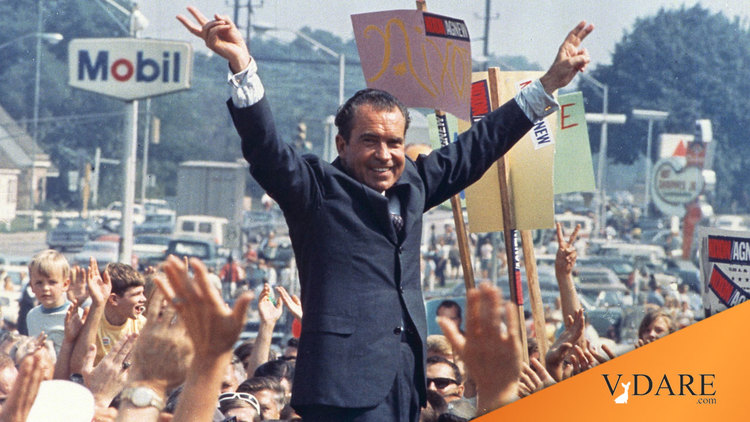


07/03/2014
![51-sjuXJb6L[1]](/assets/img/2014/07/51-sjuXJb6L1-198x300.jpg) "For the first time since President Richard M. Nixon’s divisive ’southern strategy' that sent whites to the Republican Party and blacks to the Democrats … " began a
"For the first time since President Richard M. Nixon’s divisive ’southern strategy' that sent whites to the Republican Party and blacks to the Democrats … " began a
New York Times story last week.
Thus has one of the big lies of U.S. political history morphed into a cliche — that Richard Nixon used racist politics to steal the South from a Democratic Party battling heroically for civil rights.
A brief stroll through Bruce Bartlett’s "Wrong on Race: The Democratic Party’s Buried Past" might better enlighten us.
Where Teddy Roosevelt invited Booker T. Washington to dinner, Woodrow Wilson re-segregated the U.S. government and had the pro-Klan film "Birth of a Nation" screened in his White House.
Wilson and FDR carried all 11 states of the Old Confederacy all six times they ran, when Southern blacks had no vote. Disfranchised black folks did not seem to bother these greatest of liberal icons.
As vice president, FDR chose "Cactus Jack" Garner of Texas who played a major role in imposing a poll tax to keep blacks from voting.
Among FDR’s Supreme Court appointments was Hugo Black, a Klansman who claimed FDR knew this when he named him in 1937 and that FDR told him that "some of his best friends" in Georgia were Klansmen.
Black’s great achievement as a lawyer was in winning acquittal of a man who shot to death the Catholic priest who had presided over his daughter’s marriage to a Puerto Rican.
In 1941, FDR named South Carolina Sen. "Jimmy" Byrnes to the Supreme Court. Byrnes had led filibusters in 1935 and 1938 that killed anti-lynching bills, arguing that lynching was necessary "to hold in check the Negro in the South."
FDR refused to back the 1938 anti-lynching law.
"This is a white man’s country and will always remain a white man’s country," said Jimmy. Harry Truman, who paid $10 to join the Klan, then quit, named Byrnes Secretary of State, putting him first in line of succession to the presidency, as Harry then had no V.P.
During the civil rights struggles of the '50s and '60s, Gov. Orval Faubus used the National Guard to keep black students out of Little Rock High. Gov. Ross Barnett refused to let James Meredith into Ole Miss. Gov. George Wallace stood in the door at the University of Alabama, to block two black students from entering.
All three governors were Democrats. All acted in accord with the "Dixie Manifesto" of 1956, which was signed by 19 senators, all Democrats, and 80 Democratic congressmen.
Among the signers of the manifesto, which called for massive resistance to the Brown decision desegregating public schools, was the vice presidential nominee on Adlai’s Stevenson’s ticket in 1952, Sen. John Sparkman of Alabama.
Though crushed by Eisenhower, Adlai swept the Deep South, winning both Carolinas, Georgia, Alabama, Mississippi, Louisiana and Arkansas.
Do you suppose those Southerners thought Adlai would be tougher than Ike on Stalin? Or did they think Adlai would maintain the unholy alliance of Southern segregationists and Northern liberals that enabled Democrats to rule from 1932 to 1952?
The Democratic Party was the party of slavery, secession and segregation, of "Pitchfork Ben" Tillman and the KKK. "Bull" Connor, who turned the dogs loose on black demonstrators in Birmingham, was the Democratic National Committeeman from Alabama.
And Nixon?
In 1956, as vice president, Nixon went to Harlem to declare, "America can’t afford the cost of segregation." The following year, Nixon got a personal letter from Dr. King thanking him for helping to persuade the Senate to pass the Civil Rights Act of 1957.
Nixon supported the civil rights acts of 1964, 1965 and 1968.
In the 1966 campaign, as related in my new book "The Greatest Comeback: How Richard Nixon Rose From Defeat to Create the New Majority," out July 8, Nixon blasted Dixiecrats "seeking to squeeze the last ounces of political juice out of the rotting fruit of racial injustice." [November 7, 1966]
Nixon called out segregationist candidates in '66 and called on LBJ, Hubert Humphrey and Bobby Kennedy to join him in repudiating them. None did. Hubert, an arm around Lester Maddox, called him a "good Democrat." And so were they all — good Democrats.
While Adlai chose Sparkman, Nixon chose Spiro Agnew, the first governor south of the Mason Dixon Line to enact an open-housing law.
In Nixon’s presidency, the civil rights enforcement budget rose 800 percent. Record numbers of blacks were appointed to federal office. An Office of Minority Business Enterprise was created. SBA loans to minorities soared 1,000 percent. Aid to black colleges doubled.
Nixon won the South not because he agreed with them on civil rights — he never did — but because he shared the patriotic values of the South and its antipathy to liberal hypocrisy.
When Johnson left office, 10 percent of Southern schools were desegregated. When Nixon left, the figure was 70 percent.
Richard Nixon desegregated the Southern schools, something you won’t learn in today’s public schools.
For history is a pack of lies agreed upon.
Patrick J. Buchanan is the author of the new book "The Greatest Comeback: How Richard Nixon Rose From Defeat to Create the New Majority."